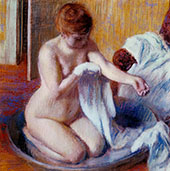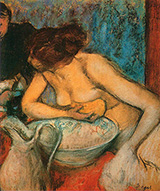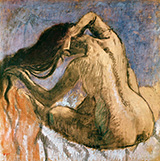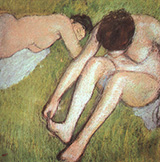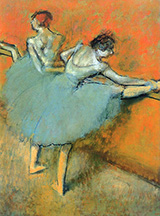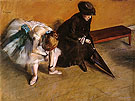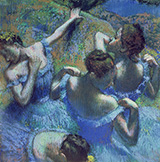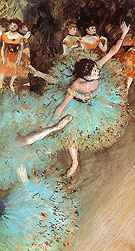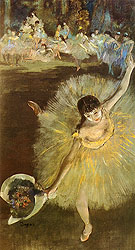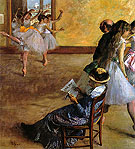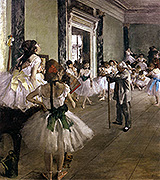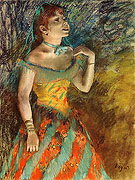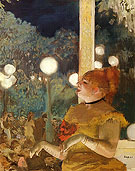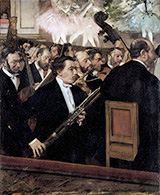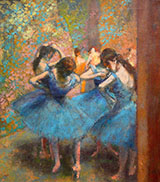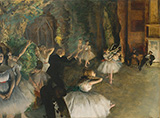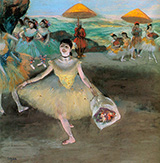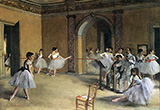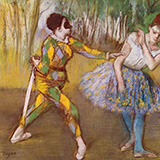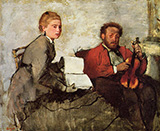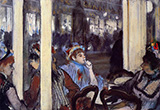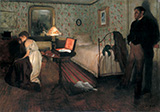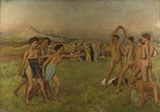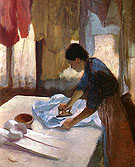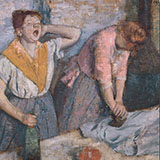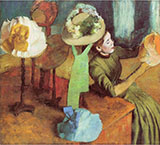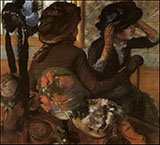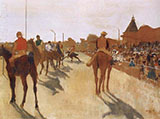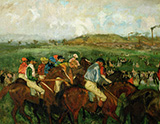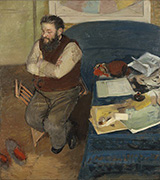Edgar Degas Oil Painting Reproductions
Edgar Degas replica paintings on Canvas for sale
Edgar Degas Famous Impressionist Artist
Edgar Degas was a pioneering artist who is famous for his Impressionist paintings. He spent most of his working life in Paris, painting working women and everyday society with unparalleled skill. Degas' ballerina paintings are popular reproduction oil paintings. Edgar Degas's impressionist art shaped European artists and their paintings for decades and maybe even centuries. His influence extends to Australian and American Impressionist art movements.
But who was the iconic painter Edgar Degas and what are his most famous paintings?
Who is Edgar Degas?
Degas grew up in Paris, France, and was born in July 1834. His father, Auguste, worked in banking, and his mother hailed from New Orleans. His mother was a skilled amateur operatic singer, and leading musicians often gave recitals from the Degas family home. Degas gained a classical education at the Lycee Louis-le-Grand, a prestigious Paris Boy’s School. During this time, Degas displayed his early talent for art. Encouraged by his father, Degas copied hundreds of artworks at the Louvre in 1853. By 18, he had created many impressive replica paintings by Raphael, Jean Auguste Dominique Ingres, and Eugene Delacroix.
Degas A Classical Art Education.
In 1855, Edgar Degas enrolled at the Ecole des Beaux-Arts. In his early portrait paintings, Degas combines the traditional teachings of his tutors and their conservative approach with new impressionist techniques. After just one year, Degas left the Ecole des Beaux-Arts and traveled through Italy. He gained an in-depth understanding of Classical Art understanding and knowledge of Old Masters paintings. Degas studied the Renaissance oil paintings of Leonardo da Vinci and Michelangelo. Indeed, his reverence for the Old Masters is apparent even in his most modern impressionist paintings. Returning to Paris in 1859, Degas focused on traditional portraiture and history painting. However, despite his classical inspiration, the powerful and highly traditional Paris Salon jury rejected his paintings.
Was Edgar Degas an Impressionist Artist?
Degas' paintings are crucial to the Impressionist Art Movement. Nonetheless, he preferred the term 'realist' when describing his oil paintings. In 1862, he met Edouard Manet. It was a momentous pairing with Degas even painting Manet’s portrait in 1866. Both artists shared disdain for the Salon art establishment. In addition, they yearned for more modern approaches to painting. They were soon joined by Claude Monet, Alfred Sisley, and Pierre-Auguste Renoir. This group of famous artists grouped and became the French impressionists, changing the art world forever.
Less than ten years later, the Franco-Prussian war erupted. Lasting from 1870-71, it ended in a violent civil war. The Third Republic wrested control of France from the infamous Paris Commune. Despite enrolling in the French National Guard, Degas escaped much of the chaos with a trip to New Orleans. It was here he painted A Cotton Office in New Orleans in 1873. Returning to Paris in late 1873, Degas founded the Société Anonyme des Artistes. This artistic group was dedicated to non-Salon exhibitions, causing a scandal with their first show. Held on 15 April 1874, this was the first Impressionist Exhibition. Edgar Degas exhibited modern portraits of working-class women featuring laundresses and his famous ballerina paintings. Degas's famous art is often painted from unusual angles and perspectives and is genuinely revolutionary.
Edgar Degas Famous Ballerina Paintings
- Edgar Degas Ballet Rehearsal 1873. Oil on canvas paintings which the Fogg Museum holds.
- The Blue Dancers 1897, now in Moscow as part of the Sergei Shchukin collection
- The Star by Edgar Degas, also known as l'Etoile and another of the famous ballerina paintings, owned by the Musee d'Orsay
- The Dance Class 1874, held by the Metropolitan Museum of Art
These paintings wonderfully contrast the grace and beauty of performance with everyday “behind the scenes” reality. Degas participated in all subsequent French impressionist exhibitions. Degas' Ballerina paintings and his impressions of working women are some of our most popular fine art reproductions.
In 1886, Degas exhibited at the final Impressionist exhibition in Paris. He showed ten paintings of bathing women, including Woman Bathing in a Shallow Tub. Degas' nude art shocked contemporary viewers. After the Bath, Woman Drying Herself is just one of the many famous nude paintings by Degas of women at their toilette. While some described his sitters as “ugly,” others praised their honesty. Despite the controversy, the theme fascinated Degas, and he completed hundreds of nude paintings, often of women bathing.
How Did Edgar Degas Change, Modern Art?
Degas changed art through his focus on modern and contemporary subjects. He painted with free, expressive brushstrokes, portraying a rapidly changing society. While Edgar Degas art isn't directly political, his paintings reflect the changing social and economic times of Paris life. For the first time, art reflected everyday life. For instance, his paintings notably charted the rise of the bourgeoisie and middle classes. Moreover, they reflect the emergence of France’s service economy, with dancers, laundresses, and waiters all attending newly affluent classes. In addition, Edgar Degas paintings reflect women’s entry into the workplace.
Although Degas used impressionist techniques of bright color and expressive brushstrokes, he carefully ordered and pre-planned all his works. Indeed, Degas once joked that he was the “least spontaneous” artist. But, he further quipped that it wouldn't be half the fun if his paintings weren't so difficult.
How did Edgar Degas contribute to impressionism?
In addition to his impressionist oil paintings, Degas also created several ballerina sculptures. Like Degas' paintings, his sculptures play with unusual angles, perspectives, and off-center designs. The Little Fourteen-Year-Old Dancer 1880 is the most famous figure. Dividing critical opinion at the time, some condemned Degas as cruel for his hyper-realistic portrayal. However, others found his hauntingly evocative creation simply brilliant.
Degas painted less in later life. Nevertheless, he continued promoting his artwork, even starting a contemporary art collection. Degas never married but had several intimate relationships during his life. Most notable was his relationship with the American Impressionist painter Mary Cassatt.
Edgar Degas died, aged 83, on 27 September 1917. He is recognized as one of the greatest impressionist painters of all time. The sheer beauty of his famous art still shines through. His intensely modern portraits, all painstakingly painted and highly refined, are truly famous impressionist paintings.
Edgar Degas Art: Museum quality oil painting on canvas
If you adore Edgar Degas' art, explore our extensive collection of fine art reproductions. Edgar Degas' paintings make fabulous wall art for any room or office. Whether you love ballerina paintings or famous nude art, enjoy replica paintings by some of the greatest Impressionist artists.
Testimonial from Jim and Sue B, Los Angeles, CA
Cannot Find What You Are Looking For?
Reproduction Gallery Information
Customer Service
(Send Us A Message)
Tel: (503) 937 2010
Fax: (503) 937 2011


